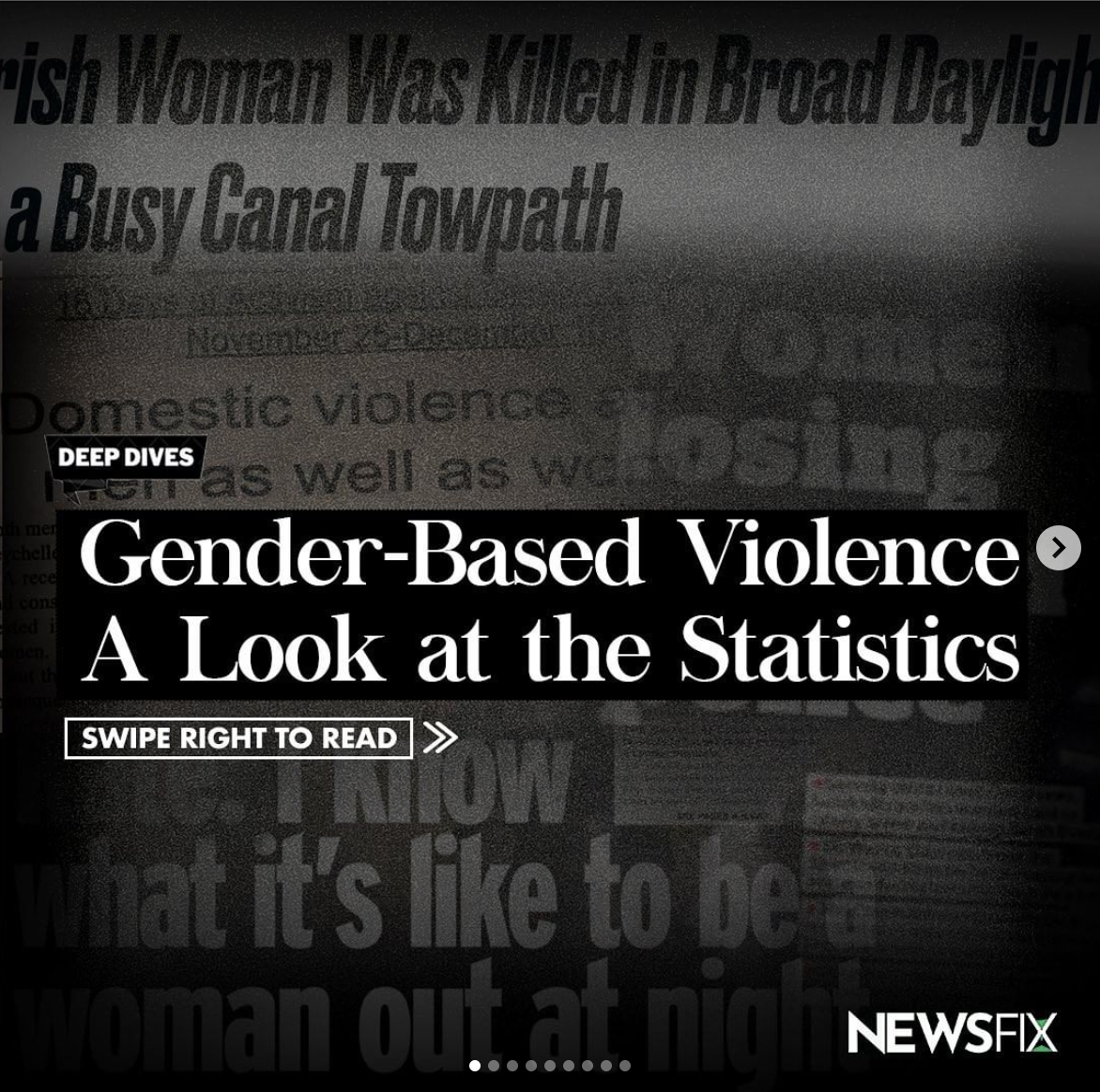📊 Gender-Based Violence: A Look at the Statistics
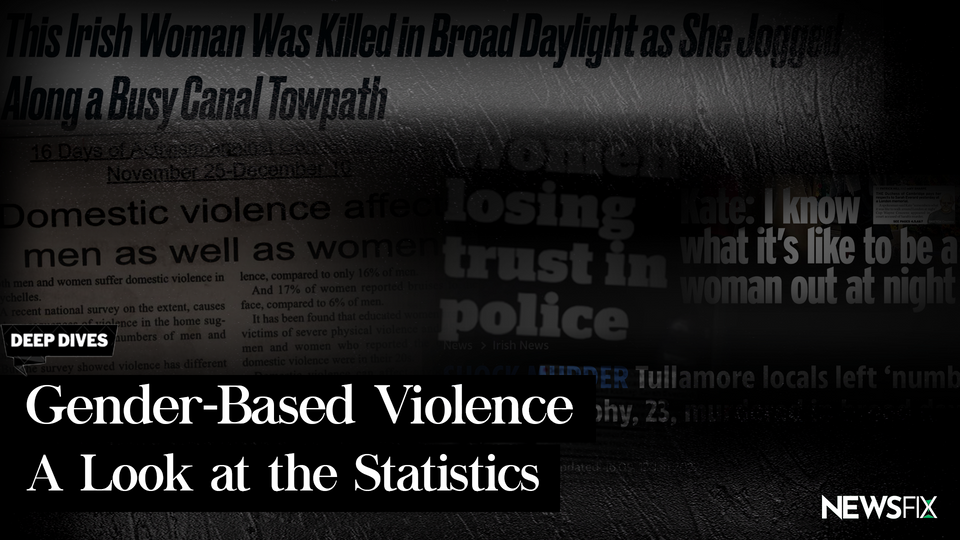
Morning all,
The senseless and brazen murder of Ashling Murphy in Ireland on Wednesday has sparked yet another debate about violence against women.
While many questions remain unanswered, we respectfully want to avoid any irresponsible speculation about this particular case. We do, however, think its important to be aware of the general statistics when it comes to gender-based violence.
We published a very similar piece less than a year ago following the murder of Sarah Everard. Let's hope this is the last version of it you have to read.
Until Monday,
Your Fixers
INTRODUCTION
There are of course a number of ways women can be victims of gender-based violence. Not all of them are sexual in nature, and we've done our best to provide and combine the most comprehensive, up-to-date research to give you a clear insight.
We have also tried to avoid making it too long a read, as it is quite statistics-heavy. Order of the piece;
- Female victims of murder
- Rape statistics
- Irish statistics
- Sexual assault and sexual harassment
FEMALE VICTIMS OF MURDER
In 2020, approximately 81,000 women and girls were killed globally, according to the UN. That's more than nine women every hour.
More than half of them (58%) were killed by an intimate partner or a family member, meaning a woman was killed in their home every 11 minutes in 2020.
When you look at the number of victims per 100,000 of the female population, Europe ranks the lowest, with 0.7 victims per 100,000.
Bigger picture: All of the statistics show that men are much more likely to be the victims of homicide than women. Less than a fifth of homicide victims are female, and that becomes 10% when you refer solely to the number of murders that occur outside of the home. However, the statistics also highlight that for the majority of women who are murdered, the crime was committed by either an intimate partner or relative.
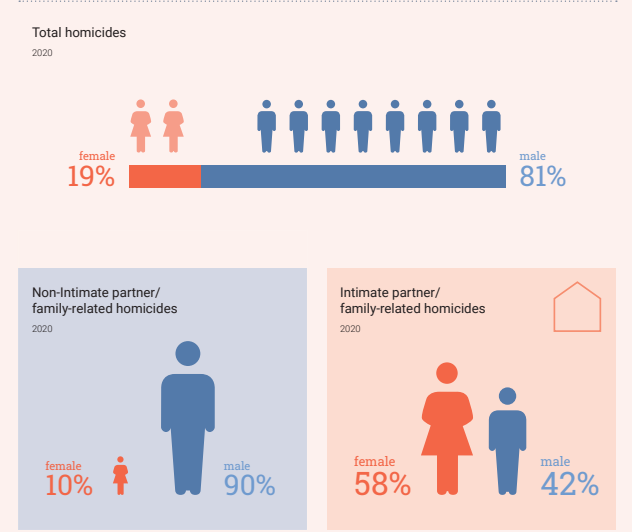
The impact of the pandemic: Between 2019 and 2020, almost all regions where trends are monitored by the UN showed an increase in the number of women being killed by partners or family members. In Western Europe, that number is understood to have increased by 11%, but the UN themselves have described their own data on this as "patchy and inconclusive".
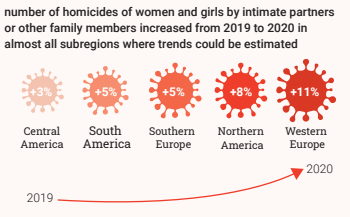
In England and Wales, 188 women were murdered in the year ending March 2020 - representing just over a quarter of all homicides. As you can see below, the number of female victims of homicide was significantly higher between 2002 and 2004 than it has been in the most recent years.
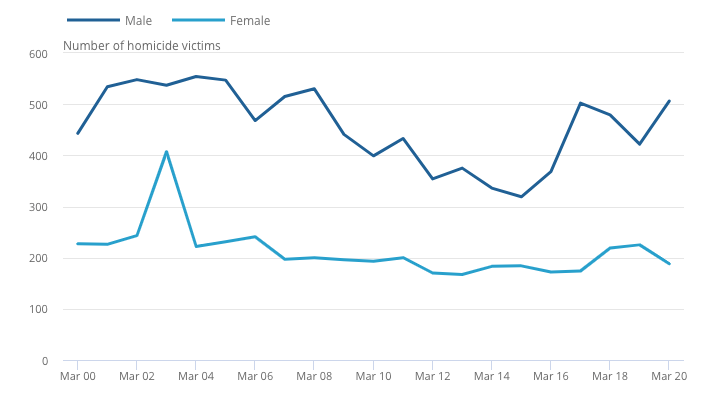
"In the UK, the Femicide Census estimates one woman is killed by a man every three days, 62% of them by a current or former partner. A history of abuse was recorded in 59% of killings of women carried out by partners or ex-partners or a male relative." - Context from The Guardian
When you collate all the women who were murdered in England and Wales in 2019, strangers accounted for 6% of the suspects.
To compare the 62% of murdered women who were killed by a current or former partner, just 7% of the men who were killed were the victims of domestic homicide.
Which women are most at risk of murder? US data indicates sex workers are 18 times more at risk of being murdered than any other woman of a similar age and race.
RAPE STATISTICS
How prevalent is rape in our society? It is estimated that around 85,000 women and 12,000 men experience rape - or attempted rape - in England and Wales every year.
When it comes to London for example, nearly 60,000 reports of rape have been filed in the last decade. That converts to about 16 reports of rape every day, with many more that never get reported to authorities.
A study cited by The Irish Times in 2020 suggested almost 15% of Irish adults have been raped at some point in their life.
Lets break the stats down further;
- Who is most likely to be raped? Women. Statistics in general show women are nine times more likely to be raped than men. In 2017, data from the UK's Home Office showed 88% of rape victims were women.
- Who is most likely to be the suspect? When it comes to women who are raped, in the vast majority of cases (90%) the suspect is said to be known to the victim. Almost half are said to be a current or former partner. The second most prominent suspect is a family member.
- How often is a victim raped by a complete stranger? The clearest data we could find shows that in approximately 13% of cases a woman is raped by a complete stranger. *We only refer to women here because there was not enough data on men.
- Where is a person most likely to be raped? At home. In 18% of cases, a rape victim is asleep or unconscious when they are attacked. Less than 10% of rape cases occur "in a park, other open public space or on the street".
- What do the statistics say about alcohol and drugs? In terms of the suspect, 38% of victims reported the person who raped them was under the influence of alcohol at the time. When it comes to victims being raped by a current or former partner, nearly a fifth say they were under the influence of alcohol when the rape occurred. This number jumps significantly when it comes to those who have been raped by a stranger - with 65% of victims saying they were under the influence of alcohol at the time.
- How often does rape end in an a conviction? First of all, rape is said to be the most under-reported crime. Of the minority who do report to police, only one in twenty end in a conviction. This figure is said to be far lower than any other crime.
The National Sexual Violence Resource Center in the US says false reporting of sexual assault lies somewhere between 2% and 10%. Figures from the UK in 2013 showed this to be much lower, but we struggled to find more recent, credible data.
"A CPS report published in 2013 showed that over a 17-month period, there were 5,651 prosecutions for rape and, during the same period, there were 35 prosecutions for making false allegations of rape." - The Crown Prosecution Service in 2020
IRELAND
When it comes to Ireland, we have looked at the CSO statistics, but we should warn those figures are "under reservation" and could be amended at a later date. That is why we have kept them separate.
What do the statistics show at the moment?
In 2020, there were 32 male victims and six female victims of murder or manslaughter in Ireland. The reports says "both the number and proportion of victims" who were female "has fallen in each of the last three years".
- 2017: 16 female victims
- 2018: 11 female victims
- 2019: 8 female victims

According to Women's Aid, 236 women in Ireland died violently between 1996 and 2020, 55% of them were killed by a partner or ex. Also, almost nine in ten of them knew their killer.
While women accounted for 44.5% of physical assault victims in Ireland in 2020, that number jumped to 79.2% of victims when it came to sexual violence.
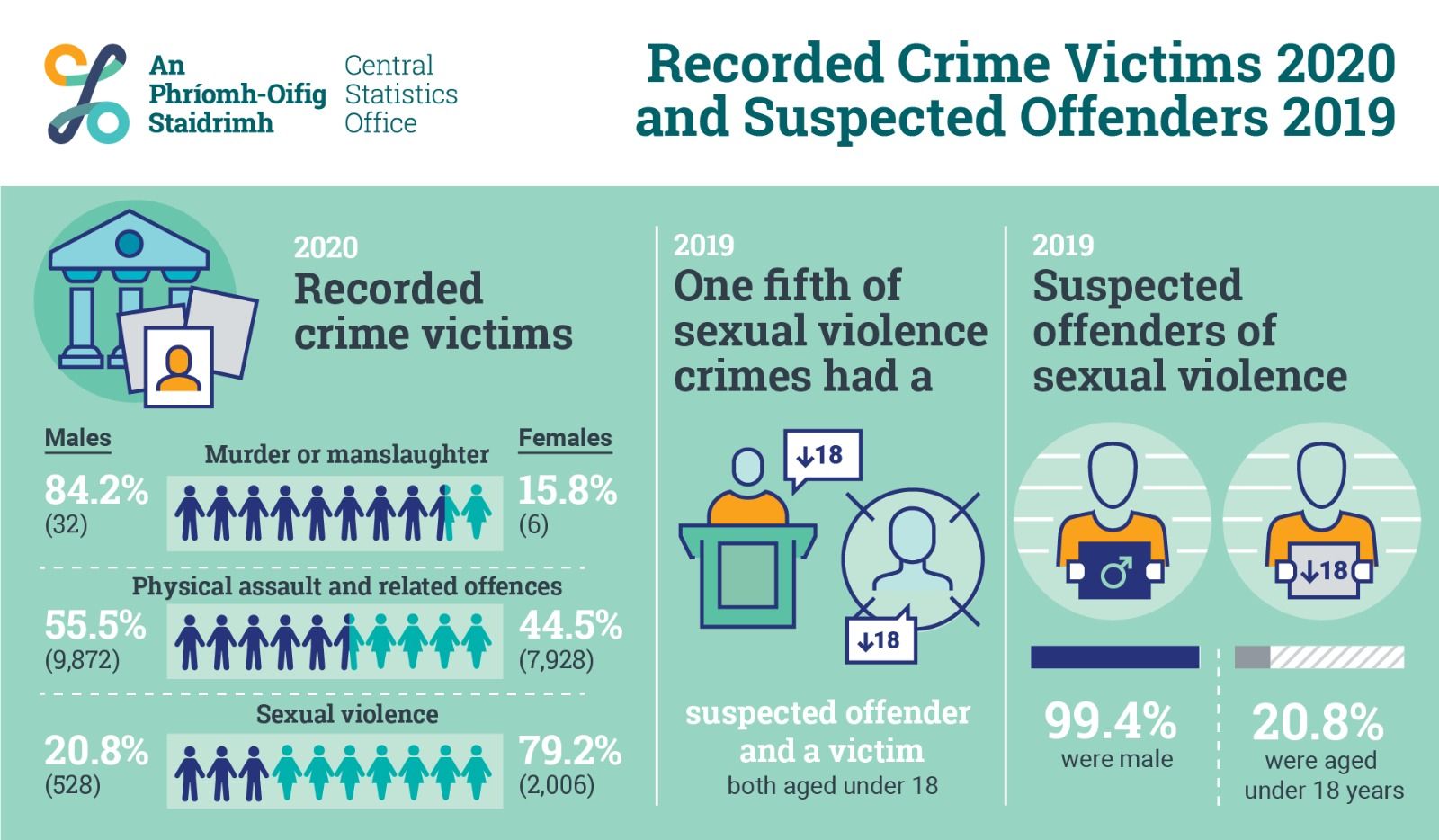
CSO statistics from recent years showed a slight increase in that number, whereby 81% of victims of sexual offences were women, and 98% of suspects were male.
Breakdown of stats on sexual crimes in Ireland;
- Male suspect offender and female victim: 79.8%
- Male suspect offender and male victim: 18.1%
- Female suspect offender and female victim: 1.6%
- Female suspect offender and male victim: 0.5%
Female offenders of sexual violence: One in every 50 offenders is a woman. One in every 200 reported cases involves a woman suspected of sexual violence against a man.
Is there any trend when it comes to age? In more than a quarter of cases, the suspect was over the age of 30 while the victim was under the age of 18.
Reporting the crime: About a quarter of victims who report the sexual crimes to police were referring to an offence that occurred more than a decade prior.
Worth comparing: The time it takes to report a sexual offence is considerably longer than for any other crime. For example, less than 1% of physical assaults and related offences recorded in 2018 related to incidents which occurred more than one year before.
How do sexual offences statistics compare to homicide? Well, it highlights the difference in gender. As mentioned, roughly 80% of sexual offence victims tend to be women. That figure is much lower - just 15.8% - when it comes to homicide.
WHAT ABOUT SEXUAL ASSAULT AND HARASSMENT?
Nearly every woman in the UK between the age of 18 and 24 has been sexually harassed, according to a UN Women UK survey published in The Guardian last year. When we say "nearly every", we mean 97%.
Almost that same number (96%) said they never reported the incidents. Some of the women who said their experience was not serious enough to report had been "groped, followed and coerced into sexual activity".
When the research applies to all adult women, the number who have been sexually harassed drops to 80%.
When it comes to sexual assault, indecent exposure or unwanted sexual touching are more common than rape or assault by penetration.
As mentioned above, four in every five women have been sexually harassed. When it comes to sexual assault, one in five have experienced "some form of sexual assault" since the age of 16 in England and Wales.
How does this compare to men? One in 25 men have experienced some form of sexual assault, meaning women are five times more likely to be victims of it.
There is no disputing the importance of this topic, and we hope you found it a helpful read. If you would like to encourage friends to read our piece, the best way you can do that is by sharing the post below from our Instagram account. Thank you.
